
Pool of Radiance is a role-playing video game developed and published by Strategic Simulations, Inc (SSI) in 1988. It was the first adaptation of TSR's Advanced Dungeons & Dragons (AD&D) fantasy role-playing game for home computers, becoming the first episode in a four-part series of D&D computer adventure games. The other games in the "Gold Box" series used the game engine pioneered in Pool of Radiance, as did later D&D titles such as the Neverwinter Nights online game. Pool of Radiance takes place in the Forgotten Realms fantasy setting, with the action centered in and around the port city of Phlan.
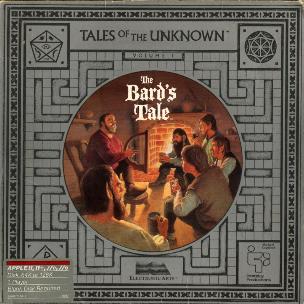
The Bard's Tale is a fantasy role-playing video game designed and programmed by Michael Cranford for the Apple II. It was produced by Interplay Productions in 1985 and distributed by Electronic Arts. The game was ported to the Commodore 64, Apple IIGS, ZX Spectrum, Amstrad CPC, Amiga, Atari ST, MS-DOS, Mac, and NES. It spawned The Bard's Tale series of games and books. The earliest editions of the game used a series title of Tales of the Unknown, but this title was dropped for later ports of The Bard's Tale and subsequent games in the series.

Wonder Boy in Monster Land, known by its original arcade release as Wonder Boy: Monster Land, is a platform video game developed by Westone Bit Entertainment and released by Sega in Japanese arcades in 1987 and for the Master System in 1988, with a number of other home computer and console ports following. The game is the sequel to the 1986 game Wonder Boy and takes place eleven years after the events in the previous game. After enjoying over a decade of peace on Wonder Land following the defeat of the evil King by Tom-Tom, later bestowed the title "Wonder Boy", a fire-breathing dragon called the MEKA dragon appeared; he and his minions conquered Wonder Land, turning it into "Monster Land". The people, helpless due to their lack of fighting skill, call for Wonder Boy, now a teenager, to destroy the monsters and defeat the MEKA dragon. Players control Wonder Boy through twelve linear levels as he makes his way through Monster Land to find and defeat the MEKA dragon. Players earn gold by defeating enemies and buy weapons, armor, footwear, magic, and other items to help along the way.
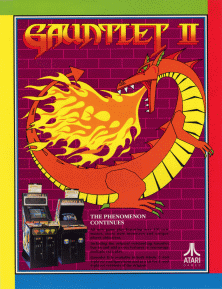
Gauntlet II is a 1986 arcade game produced by Atari Games that serves as the immediate sequel to the original Gauntlet, which was released the previous year. Like its predecessor, Gauntlet II is a fantasy-themed top down dungeon crawler game and was released as a dedicated cabinet, as well as a conversion kit, both available in 2-player and 4-player versions.
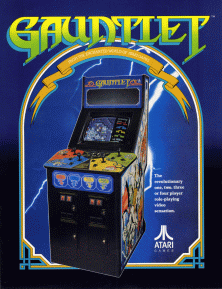
Gauntlet is a 1985 fantasy-themed hack-and-slash arcade video game developed and released by Atari Games. It is one of the first multiplayer dungeon crawl arcade games. The core design of Gauntlet comes from 1983 game Dandy for the Atari 8-bit computers, which resulted in a threat of legal action. It also has similarities to the action-adventure maze video game Time Bandit (1983).

Spellbreaker is an interactive fiction video game written by Dave Lebling and published by Infocom in 1985, the third and final game in the "Enchanter Trilogy." It was released for the Amiga, Amstrad CPC, Apple II, Atari 8-bit computers, Atari ST, Commodore 64, Classic Mac OS, and MS-DOS. Infocom's nineteenth game, Spellbreaker is rated "Expert" difficulty.

Labyrinth: The Computer Game is a graphic adventure game developed by Lucasfilm Games and published in 1986 by Activision. Based on the fantasy film Labyrinth, it tasks the player with navigating a maze while solving puzzles and evading dangers. The player's goal is to find and defeat the main antagonist, Jareth, within 13 real-time hours. Unlike other adventure games of the period, Labyrinth does not feature a command-line interface. Instead, the player uses two scrolling "word wheel" menus on the screen to construct basic sentences.
The sorcerer is a playable character class in the Dungeons & Dragons fantasy role-playing game. A sorcerer is weak in melee combat, but a master of arcane magic, generally the most powerful form of D&D magic. Sorcerers' magical ability is innate rather than studied or bargained.

The Immortal is an isometric action-adventure game originally created by Will Harvey and released by Electronic Arts in 1990 for the Apple IIGS. It was soon ported to the Amiga, Atari ST, DOS, Nintendo Entertainment System, and Genesis. A wizard is attempting to find his mentor in a large and dangerous labyrinth. It has a high degree of graphic violence. In 2020, the NES port was re-released on the Nintendo Switch Online service, while the Genesis port was re-released on the Piko Collection Collection 1 cartridge for the Evercade.
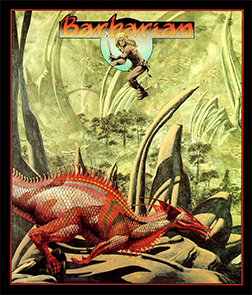
Barbarian is a 1987 platform game by Psygnosis. It was first developed for the Atari ST, and was ported to the Amiga, Commodore 64, MS-DOS, MSX, Amstrad CPC, and ZX Spectrum. The Amiga port was released in 1987; the others were released in 1988. The cover artwork is by fantasy artist Roger Dean.

Knightmare is a video game released by Activision in 1987 for ZX Spectrum, Amstrad CPC, Commodore 64, and Atari ST. It was written by Mev Dinc, J.P. Dean, E.M. Dean and Nick Cooke, and is based on the Anglia Television show Knightmare. Four years later, Mindscape released entirely different game based on the show, also called Knightmare, for the Atari ST and Amiga.
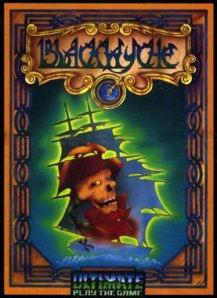
Blackwyche is an action-adventure video game published by Ultimate Play the Game for the Commodore 64 in 1985. The game is the third instalment of the Pendragon series and sequel to Entombed. In the game, aristocrat adventurer Sir Arthur Pendragon is trapped on board a haunted galleon and must free the soul of its captain. The game is presented in a 3D isometric format.
Brian Howarth is a British video game designer and computer programmer. He wrote many interactive fiction computer games in the early 1980s in a series called Mysterious Adventures. He was born in Blackpool in 1953.

Shard of Spring is a role-playing video game developed by TX Digital Illusions and published by Strategic Simulations for the Apple II, Commodore 64 and DOS computers in 1986. Shard of Spring tells the story of a group of adventurers hired to retrieve the titular magical item stolen by a power-hungry evil witch. The game was generally well received upon its release and was followed by a sequel titled Demon's Winter in 1988.
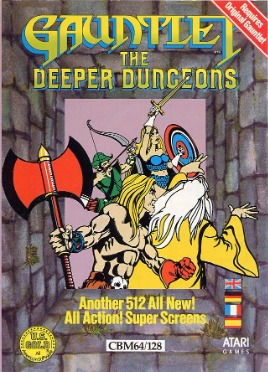
Gauntlet: The Deeper Dungeons is an expansion pack for Gauntlet.

Barbarian II: The Dungeon of Drax is a video game first published in 1988 for various home computers. It was released as Axe of Rage in North America. The game is the sequel to Barbarian: The Ultimate Warrior, which was published in 1987. In Barbarian II, the player controls a princess or barbarian character, exploring the game world to locate and defeat an evil wizard. The game's plot is an extension of its predecessor, although the gameplay is different. While the first game offers two players the opportunity for virtual head-to-head combat, the second is a single-player beat 'em up with fewer fighting moves. It uses a flip-screen style instead of scrolling.

Red Moon is the second game in the Time and Magik trilogy.

Swords and Sorcery is a fantasy role playing video game developed and published by Personal Software Services. It was released exclusively in the United Kingdom for the ZX Spectrum in 1985 and the Amstrad CPC in 1986. The game contains elements of dungeon crawling and revolves around a customisable player-character navigating through catacombs in order to secure a large wealth of treasure, whilst simultaneously collecting seven pieces of sacred armour.

Hero of the Golden Talisman is an action-adventure video game developed by British studio Mr Chip Software and published by Mastertronic in 1985 for the Commodore 64. A port to the Amstrad CPC followed. It is an early example of the Metroidvania style, despite preceding both of the genre's namesakes.
A Journey to the Centre of the Earth is a side-scrolling action-adventure platform game released for the Commodore 64 in 1984, and re-released by CRL in 1985 under the title Journey.

















